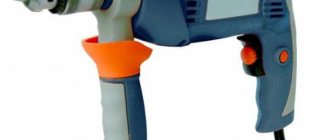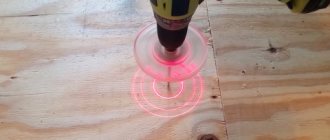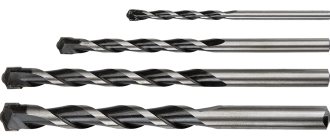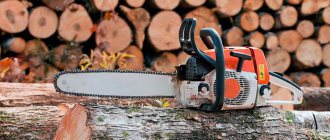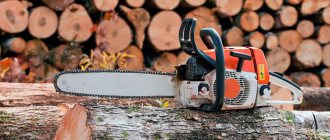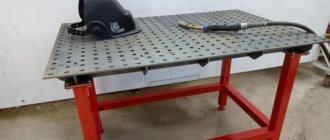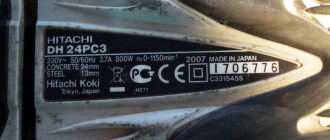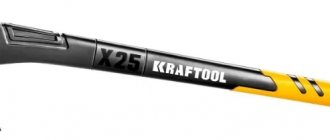Necessary tool
The need to drill into load-bearing concrete walls arises regularly (for example, when repairing or installing electrical wiring, plumbing or furniture, such as shelves or an air conditioner), but this is not easy to do - such walls are much stronger.
A hammer drill is best suited for working with concrete. It is quite powerful and has a crushing function that breaks particularly strong pieces of the wall. The kit includes a set of drills of different diameters.
In some cases, you can use a simple drill to drill a hole in concrete. It is worth using if:
- You need to make some holes.
- The depth of the hole does not exceed 1.5 cm.
- You have to drill foam concrete - when using a hammer drill it crumbles.
In other words, a drill can be used if the amount of work is small and the holes themselves are small. But experts note that using a conventional drill will make drilling labor-intensive. Not just any drill will do - it must have an impact mode and pobedite bits.
Drill modes - drilling, drilling+impact, hammer drill Source rykinekruki.ru
You can also purchase a hammer drill - a more expensive but more powerful model.
The list of things to use to drill into a concrete wall also includes a screwdriver. But the model must be powerful enough and have durable attachments, and the concrete must be light.
Tool overview
To process surfaces made of concrete, an electrically driven tool is used.
There is equipment with additional impact action, which makes it possible to obtain holes of the correct geometric shape in solid materials. Diamond drilling rigs are characterized by increased weight and dimensions; the equipment is used by construction or repair teams.
If the user needs to make single channels, and there is no electric tool available, then he needs to know how to make a hole in a concrete wall without a hammer drill. For drilling, a steel rod or a piece of pipe of suitable diameter with teeth at the end is used.
The rod is struck with a hammer, and then the improvised tool is turned 1/3 of a turn. The procedure takes a long time, the quality of the hole edges is poor.
Hammer
Drilling a hole in concrete is done with an impact drill or hammer drill; the tool allows you to drill channels up to 500 mm deep. The disadvantages of using the equipment are increased noise during operation and the risk of wall destruction due to vibration loads.
An additional disadvantage is the formation of a large amount of dust; a professional tool requires the installation of a bushing for the vacuum cleaner hose.
Regular drill or screwdriver
It is almost impossible to make a hole in a concrete wall with a hand or standard power tool. The equipment allows you to make channels of small diameter in soft material; when you try to drill into a concrete base, the drill becomes dull or breaks.
To facilitate the drilling process, a chisel or punch is used to break up solid inclusions in concrete. It will not be possible to drill concrete floors or walls without a hammer drill.
Diamond drilling
To cut holes in concrete reinforced with metal reinforcement, a diamond bit installed in special equipment is used. The tool supplies water to the working area, which cools the crown and washes away the resulting dust. The installation allows you to make a hole of large diameter; there is no damage or chips on the edge of the channel.
Selection of nozzles
The correct choice of nozzles is extremely important. For work, special nozzles of increased strength are required.
The following types are used:
- Toothed bits for impact drilling.
- Diamond bits. Their edges have special cutouts and are coated with diamond chips or corundum. They are distinguished by increased strength (they even cut reinforcement) and accuracy: the surface of the hole is perfectly smooth. They work without shock.
Diamond-coated crown Source yunimag.ru
- KS-crowns. Their edges are coated with larger diamond particles.
When working with a drill, a punch may be required. This is a special durable pin that is used for crumbling concrete. Instead, you can use a pin, core, or even an old drill.
See also: Catalog of companies that specialize in the design and reconstruction of houses of any complexity
Preparation and process
Before drilling into a concrete wall with a conventional drill, you need to inspect the tool, check its serviceability and insert the nozzle completely until it stops.
Then you will need to inspect the wall and check if wires and cables will be touched. If possible, you should also make sure that there is no reinforcement if you are using a non-diamond drill. If there may be reinforcement along the drilling path, it is necessary to prepare a metal drill.
Before you start drilling, you need to protect yourself: wear thick gloves, safety glasses, and insert earplugs or headphones.
Drilling a hole
First you need to mark the location and select the depth. Modern models usually have special limiters. If they are missing, you can put a mark on the nozzle.
A few examples will help you better understand how deep you need to drill: for a picture or a light shelf, 2.5 cm deep is enough.
Drilling with special attachments Source minemegashop.ru
When installing the dowel, the hole should be several millimeters longer. When the dowel is inserted, dust will form, which will take up extra space.
A hole is drilled in a brick or concrete wall in several steps:
- Having chosen a place and made a mark, attach the tip of the nozzle and turn on medium speed without turning on the impact mode.
- After passing a few millimeters, you need to increase the speed and turn on the shock mode. This will allow you to continue drilling smoothly without deviating due to strong vibrations.
- Every 10-15 minutes you need to stop and let the engine cool. You can continue only when the tool has completely cooled down.
- If desired, the nozzle can be regularly moistened with water so that the metal does not bend or overheat.
Working with a punch will require more time and labor. The tool itself is necessary when the wall is too hard and the drill cannot cope.
Using a limiter Source mebel-expert.info
Preparing for work
Before starting work, the drill is installed in the tool. The centralized electrical supply in the room is turned off. To supply current, extension cords are used that are connected to the distribution box. The operator wears safety glasses and a mask to protect the eyes and respiratory system from dust.
Drilling a hole
The user needs to know how to drill a concrete wall correctly. A tool with a drill or auger installed is installed on a pre-marked wall. The equipment is held by the main handle with the right hand, the left hand holds the drill body.
If there is a side handle, the operator supports the equipment with his left hand, tightly gripping the handle with his hand.
The drill rests on the surface of the wall, then the motor turns on at low speed. If a rotation speed regulator is not provided, then the operator gives several switching pulses for 1-2 seconds, ensuring that the cutting edge of the drill deepens into the concrete surface.
At the same time, the perpendicularity of the axes of the tool and the concrete wall is controlled. Then drilling is carried out with the impact mode turned on, the cutting speed is determined by the force of pressing the drill and the rotational speed of the drill or drill.
When drilling deep holes, it is recommended to remove the drill from the channel to remove dust and chips. When encountering metal reinforcement, it is permissible to use a metal drill; in most cases, the impact force of the drill in a hammer drill is sufficient to destroy a rod made of mild structural steel.
Tips for performing work
Before drilling a hole in concrete, it is recommended that you familiarize yourself with these helpful guidelines:
- If a plastic dowel is supposed to be installed in the hole, then the length of the channel should exceed the length of the dowel by 10-15 mm. The gap is used to collect concrete chips from the walls of the hole.
- When starting drilling, it is necessary to set the minimum speed. The drill does not move along the surface, which allows you to drill holes in accordance with the markings. As the drill deepens, it is necessary to increase the speed and increase the load on the drill or hammer drill.
- If the drill bit slips in the chuck (due to wear or damage to the jaws), the clamping fixture must be replaced. Operating a drill with a damaged chuck leads to misalignment of equipment parts and a decrease in the quality of the work performed.
Video description
This video shows how to drill a hole with a diamond drill bit:
Diamond drilling is carried out in 2 ways - dry and wet. In the second case, when drilling, water constantly flows onto the working surface. It cools the drill and reduces noise; dust settles in it. However, if electrical wiring runs nearby or constant access to water is not possible, the dry method is used.
Diamond drilling produces smooth holes Source kas.kz
Useful tips
The drilling process is simple, but it requires certain dexterity and skills. It is important to keep the tool level so as not to displace the drill and increase the load.
Some tips will help simplify the work and make the hole in the wall neat:
- You can't skimp on drills. Poor quality attachments break and bend easily.
- You can determine the presence of fittings with a metal detector.
- When installing the dowel, the hole should be several millimeters longer than the fastening. These extra millimeters will be clogged with cement dust when the dowel is inserted.
- If it is necessary to make a through hole, at the end of drilling, when approaching the opposite side, the speed must be reduced. This will help prevent the concrete from chipping.
- When using a low-power drill, it is important to regularly, every 10-15 minutes, stop and cool the motor. This will help prevent damage to the instrument.
- When drilling, it will be dusty, and therefore, before drilling into a concrete wall, it is better to prepare a vacuum cleaner. It is better to use a construction vacuum cleaner, since household models will quickly deteriorate from small crumbs.
When drilling, a lot of dust rises Source waysi.ru
Sometimes the nozzles get stuck in the block. They should not be pulled by force, as they can easily break and leave a piece in the wall forever. You need to disconnect it, attach a smaller nozzle, and drill into the wall nearby.
A short story about how to drill into a concrete wall without breaking the drill
From the author: good afternoon. Now my story will be about how I broke a drill and a drill, and also broke off a piece of the wall, just trying to make a hole in order to insert a cable for a new socket. Before I tell you how this happened, I’ll clarify where I got the knowledge and experience in this matter.
The wall I broke the drill on was brick. After this incident, not knowing how to drill a concrete wall correctly, I began to consult with my familiar builders, read articles on the Internet and analyze the incorrectness of my actions. Having synthesized all the knowledge and made a couple of conclusions, I am ready to present you with a few lines on this topic. Let's begin.
What mistakes did I make and what mistakes should you not make?
The wall I was drilling was quite thick. About thirty centimeters. She stood as a barrier between the kitchen and the loggia. Why drill? I'm not a big fan of boxes and I think that they look extremely unesthetically pleasing, so it's better to make one small hole in the wall to thread the cable through, rather than spoil the appearance with a bunch of plastic.
Armed with a hammer drill, I got to work. The first mistake I made was putting too much pressure on the wall at the beginning of the drilling process. You see, if the drill bit is quite long, putting too much pressure on it will create unnecessary deformation, which will either break the bit itself or cause the chuck to become loose.
In my case it was the second option, and the cartridge was practically torn from the base due to the vibrations created. Fortunately, I had a hammer drill at home, and I easily did the same procedure with a brick wall without any problems.
I’ll explain why I didn’t immediately use a hammer drill, because that’s what it’s designed for. The answer is simple. I knew that the wall was made of brickwork, which means that it was an order of magnitude softer than concrete. Therefore, using an impact drill seemed optimal to me. There was no desire to take out a huge, in my opinion, hammer drill from the pantry, but the miser pays twice.
The second attempt to take the brick wall was successful. The next step was to make holes in the concrete ceiling slab, which would later hold the profiles for the plasterboard sheets. For this I used a drill much smaller. It was eight millimeters in diameter and about 9–10 centimeters in length.
Already with a hammer drill in my hands, I climbed onto the ladder, raised my head up, chose a place and began to drill. The stove did not give in to me. I decided that the effort was not enough, and it would be quite reasonable to push even harder. Having pressed, all I managed to see was the moment the drill broke into two halves, lasting one moment, and how the upper (broken off) part fell right into my eye.
Without having time to react to the attack of the drill, I just stood there, petrified. The fragment hit the safety glasses, was deflected and fell to the ground. At that moment, I realized that it was not in vain that I studied safety precautions so diligently and always follow them. Otherwise, I would have been left without an eye out of stupidity. The mistake this time was that next to the Pobedit drill I needed for working with concrete walls and slabs there was another, ordinary one, which in appearance was barely different from what was needed.
A mistake was made, but not in vain. You see, an ordinary drill, although barely, drills through concrete. It made a small hole in the ceiling, allowing the drill not to slip on the surface. The main thing is not to overdo it when doing it.
So, the mistakes I made:
- pressed too hard on the drill when drilling a hole;
- made a mistake when choosing a drill;
- overestimated the talent of the impact drill.
Avoid these mistakes and using the instructions below, you will achieve the desired result without any problems.
I would also like to once again draw additional attention to safety precautions. Quite a few people neglect to even use safety glasses, ending up damaging their eyes and, at best, losing their vision. It wouldn't be difficult for anyone to put a little plastic on their face to stay intact.
Algorithm for correct drilling of a concrete wall
The first thing you should know is that the drill must enter perpendicularly, creating a right angle between the drill and the plane of the wall. Otherwise, you may damage your hands, the tool, or the surface itself, causing unwanted scratches.
When drilling concrete, this is not the most important thing, but if you do not get used to these rules, then when working on a ceramic surface or tile, you may end up with debris in your hands, and when making a hole in the wall with decorative putty or plaster casting, you will not have time to come to your senses, how tears will flow from your eyes saying goodbye to your favorite decor.
If you do not have enough physical strength to hold a hammer drill or drill evenly with one hand, we recommend using the additional handle that always comes with any hand tool. When working, do not hold the drill by the body, as you may receive a small electrical discharge. Not fatal to life, but rather unpleasant and frightening, which, in turn, can cause trouble.
Select a drill bit that is designed for creating holes in concrete structures. It has a pobedit tip, and is popularly called a “pobedit drill.” What is it that will win? It is an alloy of cobalt and tungsten carbide, which is incredibly hard and durable. If you need to create a hole in a concrete wall to install a new socket, then there are special drills for such work with Pobedit tips that will make the job easier. So, we have decided on the nozzle. Now it's time to do the same with the tool.
You can use either an impact drill or a hammer drill. Depending on how deep the hole should be and how wide it is. If its diameter exceeds thirteen millimeters, then the hammer drill will be a more reliable gadget.
A small life hack: do not rush to drill a hole right away, adding high speeds and pressing hard on the drill. First, make a small depression like I did, which will allow the drill bit to not move from side to side and slide across the entire surface of the wall. And one more piece of advice. When working, dip the drill bit into a glass of water from time to time to prevent it from overheating.
Too lazy to clean up later?
Is it possible without dust? To solve this problem, the ingenuity of the Slavic peoples entered the battle, which is beyond the control of Western dust-catchers. A fairly adequate desire in this case is to simplify the process by eliminating dust after it’s finished, because no normal man enjoys cleaning. Yes, you can’t find anything on Aliexpress and Ebay, but nothing will save you money and amuse others better than making your own inventions.
A fairly common way to collect dust is to create a small envelope. Place it under the place where you will drill and take out the video camera to amuse your friends later.
One example of how the mind works is in the video below:
I will share my personal experience. More precisely, the experience of my father, who finds a sound solution in any situation. Before he starts drilling something, he takes a vacuum cleaner and calls someone who is closest. Further according to the algorithm.
- Before you bring the vacuum cleaner tube to the place where you will make the hole, turn it on.
- Use a vacuum cleaner to catch dust that falls on the floor during drilling.
- Don’t force anyone to clean up after you and don’t suffer from this process yourself.
Be careful in your work and happy in life. Best wishes!
seberemont.ru
Briefly about the main thing
To drill a hole in concrete, use a powerful drill or hammer drill.
The bits must be strong enough to penetrate the stone without getting damaged. When working with walls that have reinforcement, you will need a metal nozzle.
Before you start drilling, you need to check whether there are any wires or pipes running inside the wall. It is also advisable to make sure that there is no reinforcement.
The process itself is simple and requires only care and skill. The main thing is not to overheat the tool’s motor and make sure that the drill does not go to the side.
Ratings 0
